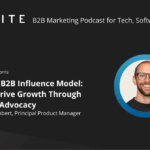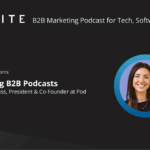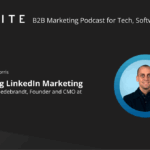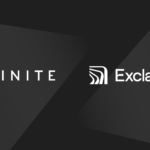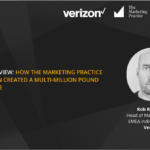Account-based marketing is an agile strategy, not just across teams and channels, but objectives. In 2022, B2B marketers understand the advantages of ABM for lead generation, customer retention and account expansion, but what role can ABM play in a partnership programme?
We interviewed Rob Reynolds, Head of Marketing GSI & EMEA indirect channel at Verizon, to find out why he chose ABM as a business strategy to grow channel revenues, how they implemented the programme alongside sales and the metrics they measured to showcase success.
Rob worked with The Marketing Practice to launch this new channel marketing initiative, including building out the target account list, defining the value proposition and creating collateral and a GTM plan.
Why was ABM the best fit to reach this objective and how did it lay the groundwork for your strategy?
Given the small amount of potentially high value relationships, ABM was the best-fit strategy to help us reach our ambitious objectives. In doing 1:1 and 1:few ABM, we were able to deliver a core value proposition in a targeted way to showcase specifically how we are a relevant partner for prospective GSIs.
At the beginning of the programme, we undertook in-depth research in order to familiarise ourselves with the market. This informed our wider strategy, and helped us refine our target account list. The Marketing Practice engaged a specialist channel consultant who performed this research, alongside audience interviews that would help us learn what drives GSI’s businesses, and their appetite for new relationships.
This is when we decided ABM was the best strategy to connect with the GSIs, with messaging informed by our findings. We initially had a rather long list of accounts, which was then reduced based on those GSIs likelihood of partnering with Verizon and their existing partnerships. We highlighted one account as highly important, therefore that account was given a 1:1 programme, whereas the remaining accounts were grouped into a 1:few campaign.
Could you please give us more detail as to your 1:1 and 1:few campaigns?
In assessment of Verizon Business’ key strengths, and utilising in-depth market research, we produced a strategy around the line ‘build on the best’. This concept refers to the fact that Verizon has been Gartner’s Magic Quadrant Leader for Network Services 15 years in a row. With this proposition, GSIs would feel reassured of premium technology with which they could build an integrated solution.
Using Marketo for 1:1 communications into the target accounts, we delivered the ‘build on the best’ concept through brand awareness emails, alongside customised content like one-pagers and full manifestos. In deploying these to target contacts directly, we were able to demonstrate the value proposition for each GSI specifically. The Marketing Practice’s inside sales team produced personalised messages that they would send in email and InMail and use to start conversations.
How did you work with sales to kickstart the programme and support throughout?
It was clear to me that in order for an indirect go-to-market approach to succeed, we would need to have sales involved from the start and deeply throughout, including during the agency pitching process when we chose The Marketing Practice.
Myself and the sales team were impressed by TMP’s deep understanding of both the marketing and sales end of ABM. This, their partner and ABM experience, and their access to in-house sales reps, meant we felt assured in working with them to kickstart the programme, through strategy, all the way to lead nurturing. Additionally, their in-house data and analytics experts could help me build a custom dashboard that would track multi-touch attribution.
The success of this programme could largely be attributed to the way it was managed, and the tight-knit marketing and sales teams were constantly in touch with the agency. Additionally, when a member of the Verizon sales team felt challenged in moving forward with an opportunity, we could turn to The Marketing Practice’s inside sales team to find alternative contacts within the target organisation and start new conversations.
Working so tightly with sales is largely the reason we smashed our initial meeting target of 10, instead generating 22 meetings with key accounts.
How did you measure the success of the programme?
In terms of individual metrics, such as calls, emails and event attendance, these were easy to track. However, determining the impact of these interactions on our revenue objectives was a little more tricky. If the value of the programme’s entirety was to be understood by senior leadership, we had to overcome this challenge early on.
The Marketing Practice’s in-house data and analytics expert built a custom dashboard that would track the status and engagement of accounts and attribute these to revenue. We used a multi-touch attribution model built on a comprehensive Power BI. Then, when accounts hit a certain score, we could attribute this directly to our marketing efforts alongside qualified leads who we could see came directly from our campaigns.
Within a year of the programme, we smashed our target of 10 meetings, and instead booked a whopping 22, lending to a multi-million dollar pipeline value! Given the success of the programme in the EMEA region, we expanded globally over the next two years, where we generated a total of 127 MQLs across EMEA, US and APAC.
We’re looking forward to seeing where we can take it next.

